An Examination of the Inequity in Educational Resource Distribution
VerifiedAdded on 2022/10/17
|5
|1123
|306
Essay
AI Summary
This essay delves into the critical issue of inequity in the distribution of educational resources, exploring the multifaceted factors that contribute to this disparity. The analysis begins by defining educational resources and highlighting the shift towards open and accessible online materials. However, the essay underscores the increasing inequality in their distribution, attributing it to marginalization, limited funding, a lack of qualified teachers, and social exclusion. The essay examines how family background, gender, race, immigrant status, and aboriginal status influence access to educational resources, with a particular focus on the differences between developed and developing countries. The author references several academic sources, including studies on open educational resources, racial privilege, and resource distribution in K-12 education, to support the claims. Overall, the essay provides a comprehensive overview of the challenges in achieving equitable educational access and highlights the need for addressing these inequalities.
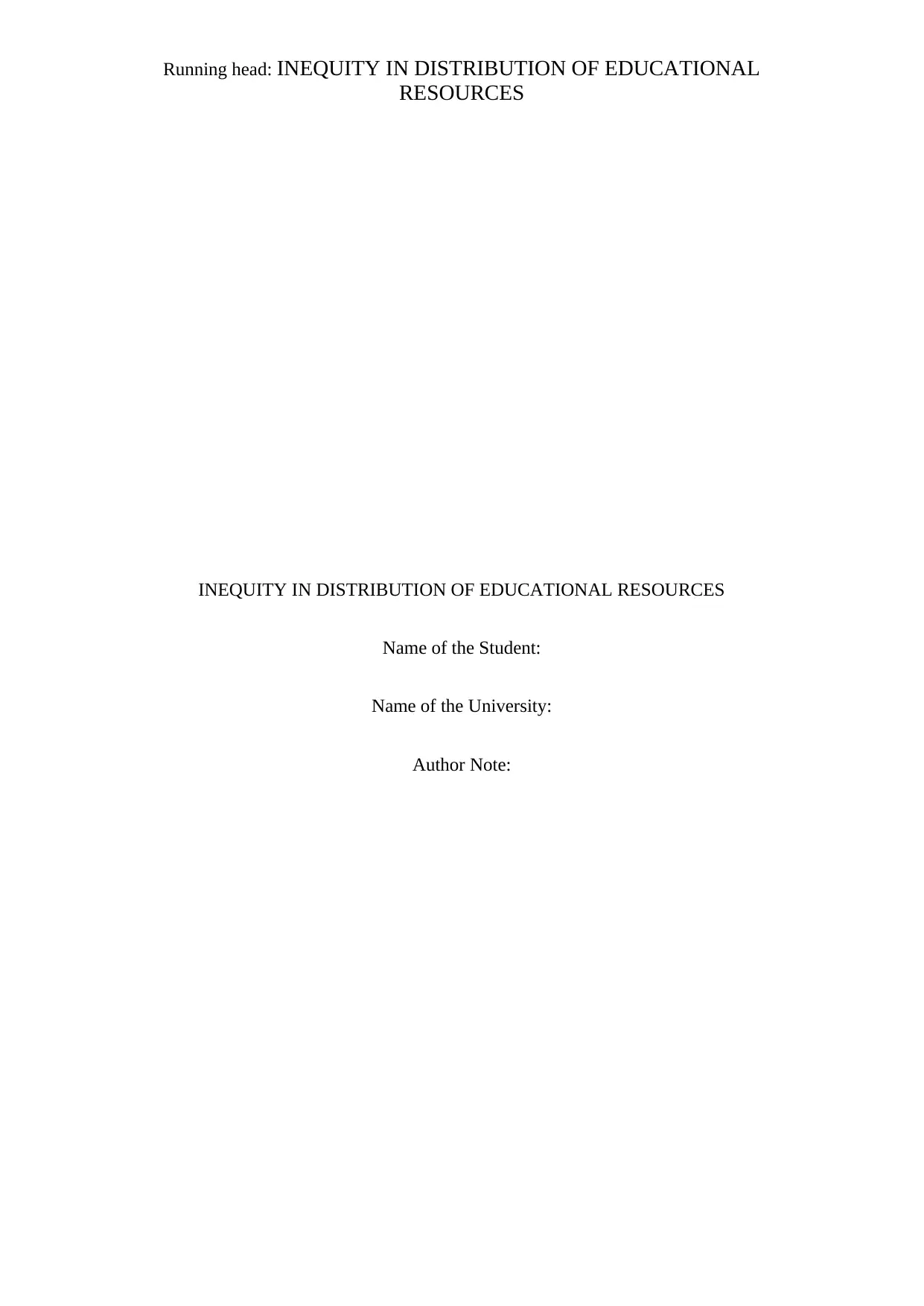
Running head: INEQUITY IN DISTRIBUTION OF EDUCATIONAL
RESOURCES
INEQUITY IN DISTRIBUTION OF EDUCATIONAL RESOURCES
Name of the Student:
Name of the University:
Author Note:
RESOURCES
INEQUITY IN DISTRIBUTION OF EDUCATIONAL RESOURCES
Name of the Student:
Name of the University:
Author Note:
Paraphrase This Document
Need a fresh take? Get an instant paraphrase of this document with our AI Paraphraser
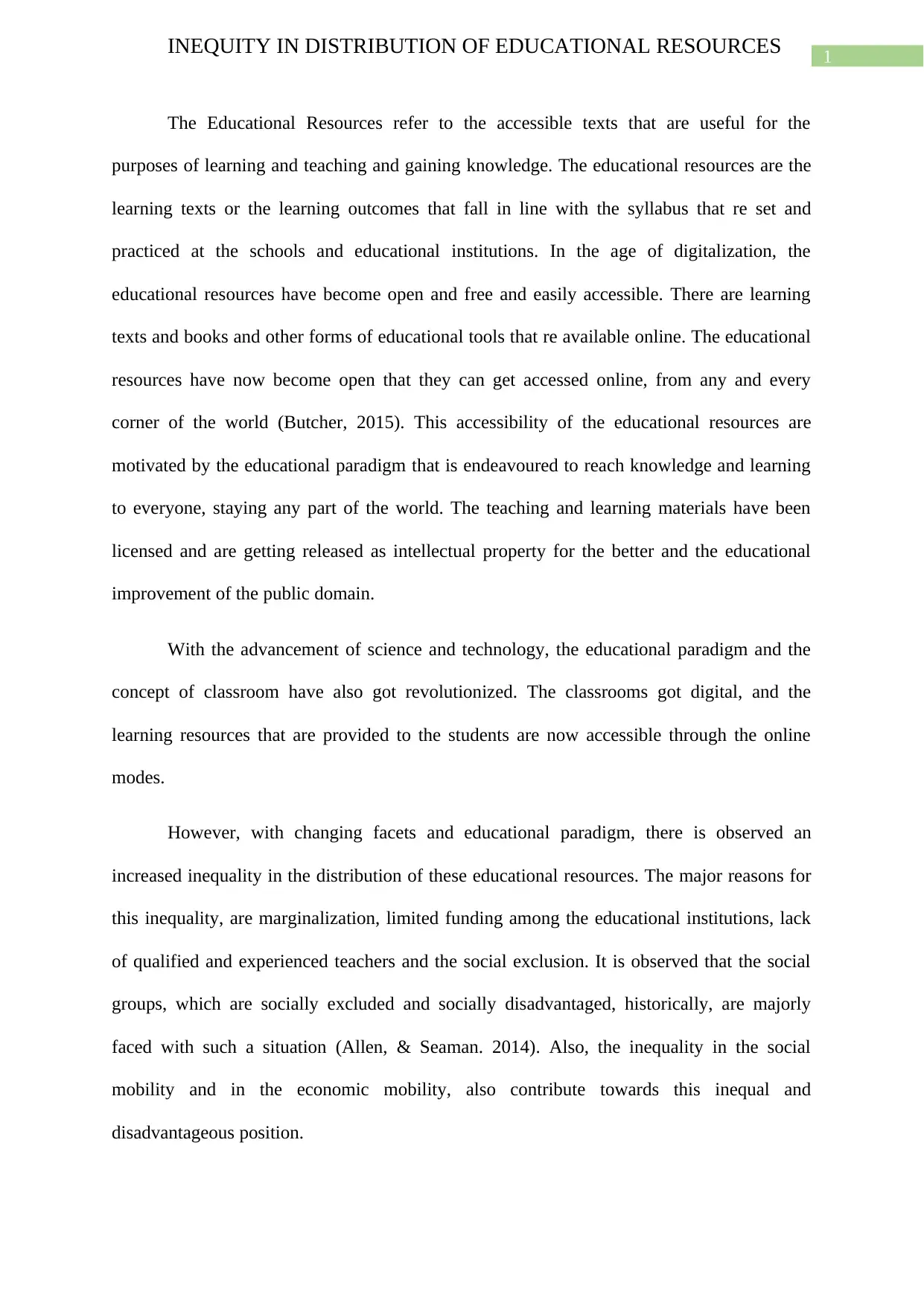
1
INEQUITY IN DISTRIBUTION OF EDUCATIONAL RESOURCES
The Educational Resources refer to the accessible texts that are useful for the
purposes of learning and teaching and gaining knowledge. The educational resources are the
learning texts or the learning outcomes that fall in line with the syllabus that re set and
practiced at the schools and educational institutions. In the age of digitalization, the
educational resources have become open and free and easily accessible. There are learning
texts and books and other forms of educational tools that re available online. The educational
resources have now become open that they can get accessed online, from any and every
corner of the world (Butcher, 2015). This accessibility of the educational resources are
motivated by the educational paradigm that is endeavoured to reach knowledge and learning
to everyone, staying any part of the world. The teaching and learning materials have been
licensed and are getting released as intellectual property for the better and the educational
improvement of the public domain.
With the advancement of science and technology, the educational paradigm and the
concept of classroom have also got revolutionized. The classrooms got digital, and the
learning resources that are provided to the students are now accessible through the online
modes.
However, with changing facets and educational paradigm, there is observed an
increased inequality in the distribution of these educational resources. The major reasons for
this inequality, are marginalization, limited funding among the educational institutions, lack
of qualified and experienced teachers and the social exclusion. It is observed that the social
groups, which are socially excluded and socially disadvantaged, historically, are majorly
faced with such a situation (Allen, & Seaman. 2014). Also, the inequality in the social
mobility and in the economic mobility, also contribute towards this inequal and
disadvantageous position.
INEQUITY IN DISTRIBUTION OF EDUCATIONAL RESOURCES
The Educational Resources refer to the accessible texts that are useful for the
purposes of learning and teaching and gaining knowledge. The educational resources are the
learning texts or the learning outcomes that fall in line with the syllabus that re set and
practiced at the schools and educational institutions. In the age of digitalization, the
educational resources have become open and free and easily accessible. There are learning
texts and books and other forms of educational tools that re available online. The educational
resources have now become open that they can get accessed online, from any and every
corner of the world (Butcher, 2015). This accessibility of the educational resources are
motivated by the educational paradigm that is endeavoured to reach knowledge and learning
to everyone, staying any part of the world. The teaching and learning materials have been
licensed and are getting released as intellectual property for the better and the educational
improvement of the public domain.
With the advancement of science and technology, the educational paradigm and the
concept of classroom have also got revolutionized. The classrooms got digital, and the
learning resources that are provided to the students are now accessible through the online
modes.
However, with changing facets and educational paradigm, there is observed an
increased inequality in the distribution of these educational resources. The major reasons for
this inequality, are marginalization, limited funding among the educational institutions, lack
of qualified and experienced teachers and the social exclusion. It is observed that the social
groups, which are socially excluded and socially disadvantaged, historically, are majorly
faced with such a situation (Allen, & Seaman. 2014). Also, the inequality in the social
mobility and in the economic mobility, also contribute towards this inequal and
disadvantageous position.
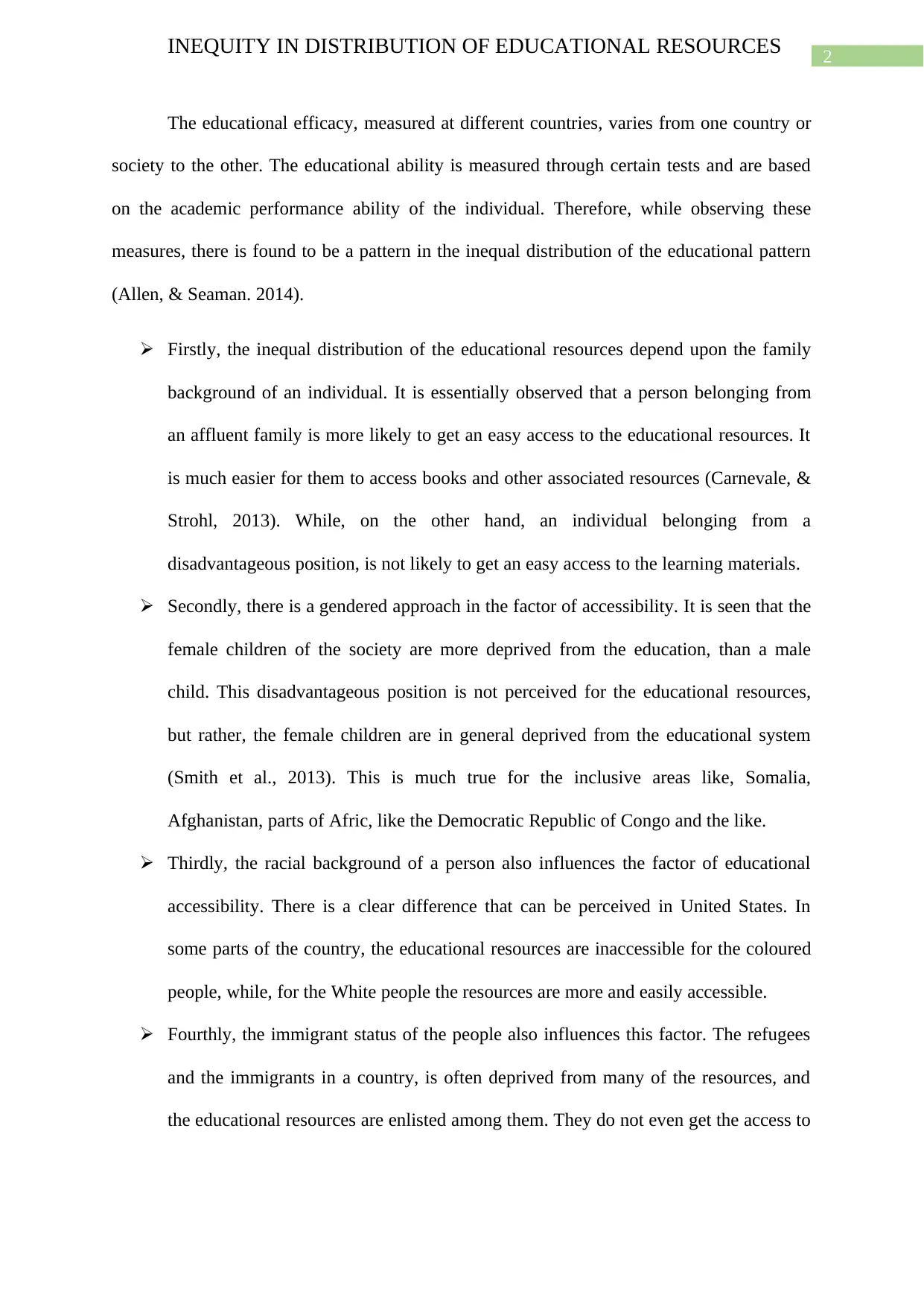
2
INEQUITY IN DISTRIBUTION OF EDUCATIONAL RESOURCES
The educational efficacy, measured at different countries, varies from one country or
society to the other. The educational ability is measured through certain tests and are based
on the academic performance ability of the individual. Therefore, while observing these
measures, there is found to be a pattern in the inequal distribution of the educational pattern
(Allen, & Seaman. 2014).
Firstly, the inequal distribution of the educational resources depend upon the family
background of an individual. It is essentially observed that a person belonging from
an affluent family is more likely to get an easy access to the educational resources. It
is much easier for them to access books and other associated resources (Carnevale, &
Strohl, 2013). While, on the other hand, an individual belonging from a
disadvantageous position, is not likely to get an easy access to the learning materials.
Secondly, there is a gendered approach in the factor of accessibility. It is seen that the
female children of the society are more deprived from the education, than a male
child. This disadvantageous position is not perceived for the educational resources,
but rather, the female children are in general deprived from the educational system
(Smith et al., 2013). This is much true for the inclusive areas like, Somalia,
Afghanistan, parts of Afric, like the Democratic Republic of Congo and the like.
Thirdly, the racial background of a person also influences the factor of educational
accessibility. There is a clear difference that can be perceived in United States. In
some parts of the country, the educational resources are inaccessible for the coloured
people, while, for the White people the resources are more and easily accessible.
Fourthly, the immigrant status of the people also influences this factor. The refugees
and the immigrants in a country, is often deprived from many of the resources, and
the educational resources are enlisted among them. They do not even get the access to
INEQUITY IN DISTRIBUTION OF EDUCATIONAL RESOURCES
The educational efficacy, measured at different countries, varies from one country or
society to the other. The educational ability is measured through certain tests and are based
on the academic performance ability of the individual. Therefore, while observing these
measures, there is found to be a pattern in the inequal distribution of the educational pattern
(Allen, & Seaman. 2014).
Firstly, the inequal distribution of the educational resources depend upon the family
background of an individual. It is essentially observed that a person belonging from
an affluent family is more likely to get an easy access to the educational resources. It
is much easier for them to access books and other associated resources (Carnevale, &
Strohl, 2013). While, on the other hand, an individual belonging from a
disadvantageous position, is not likely to get an easy access to the learning materials.
Secondly, there is a gendered approach in the factor of accessibility. It is seen that the
female children of the society are more deprived from the education, than a male
child. This disadvantageous position is not perceived for the educational resources,
but rather, the female children are in general deprived from the educational system
(Smith et al., 2013). This is much true for the inclusive areas like, Somalia,
Afghanistan, parts of Afric, like the Democratic Republic of Congo and the like.
Thirdly, the racial background of a person also influences the factor of educational
accessibility. There is a clear difference that can be perceived in United States. In
some parts of the country, the educational resources are inaccessible for the coloured
people, while, for the White people the resources are more and easily accessible.
Fourthly, the immigrant status of the people also influences this factor. The refugees
and the immigrants in a country, is often deprived from many of the resources, and
the educational resources are enlisted among them. They do not even get the access to
⊘ This is a preview!⊘
Do you want full access?
Subscribe today to unlock all pages.

Trusted by 1+ million students worldwide
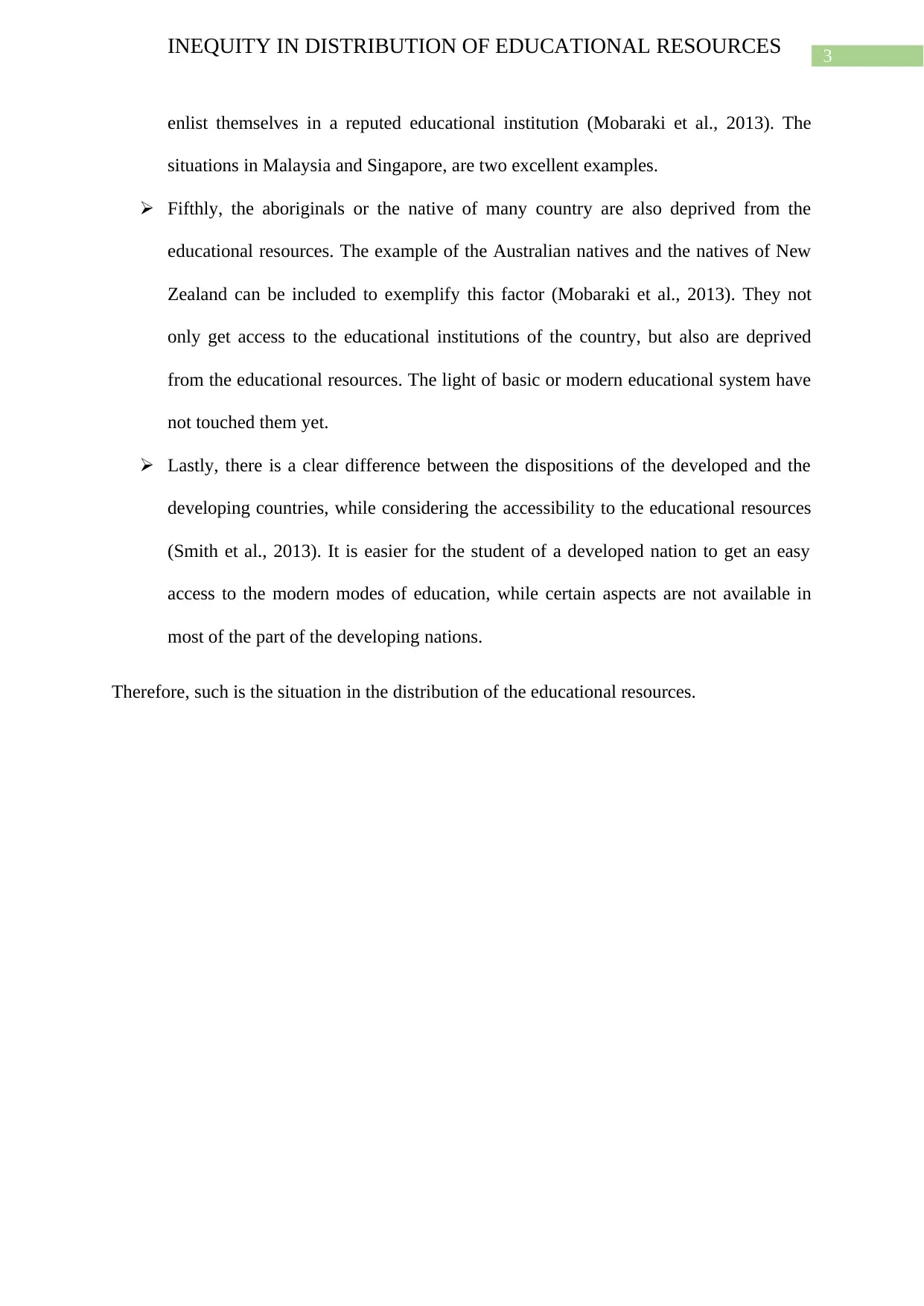
3
INEQUITY IN DISTRIBUTION OF EDUCATIONAL RESOURCES
enlist themselves in a reputed educational institution (Mobaraki et al., 2013). The
situations in Malaysia and Singapore, are two excellent examples.
Fifthly, the aboriginals or the native of many country are also deprived from the
educational resources. The example of the Australian natives and the natives of New
Zealand can be included to exemplify this factor (Mobaraki et al., 2013). They not
only get access to the educational institutions of the country, but also are deprived
from the educational resources. The light of basic or modern educational system have
not touched them yet.
Lastly, there is a clear difference between the dispositions of the developed and the
developing countries, while considering the accessibility to the educational resources
(Smith et al., 2013). It is easier for the student of a developed nation to get an easy
access to the modern modes of education, while certain aspects are not available in
most of the part of the developing nations.
Therefore, such is the situation in the distribution of the educational resources.
INEQUITY IN DISTRIBUTION OF EDUCATIONAL RESOURCES
enlist themselves in a reputed educational institution (Mobaraki et al., 2013). The
situations in Malaysia and Singapore, are two excellent examples.
Fifthly, the aboriginals or the native of many country are also deprived from the
educational resources. The example of the Australian natives and the natives of New
Zealand can be included to exemplify this factor (Mobaraki et al., 2013). They not
only get access to the educational institutions of the country, but also are deprived
from the educational resources. The light of basic or modern educational system have
not touched them yet.
Lastly, there is a clear difference between the dispositions of the developed and the
developing countries, while considering the accessibility to the educational resources
(Smith et al., 2013). It is easier for the student of a developed nation to get an easy
access to the modern modes of education, while certain aspects are not available in
most of the part of the developing nations.
Therefore, such is the situation in the distribution of the educational resources.
Paraphrase This Document
Need a fresh take? Get an instant paraphrase of this document with our AI Paraphraser
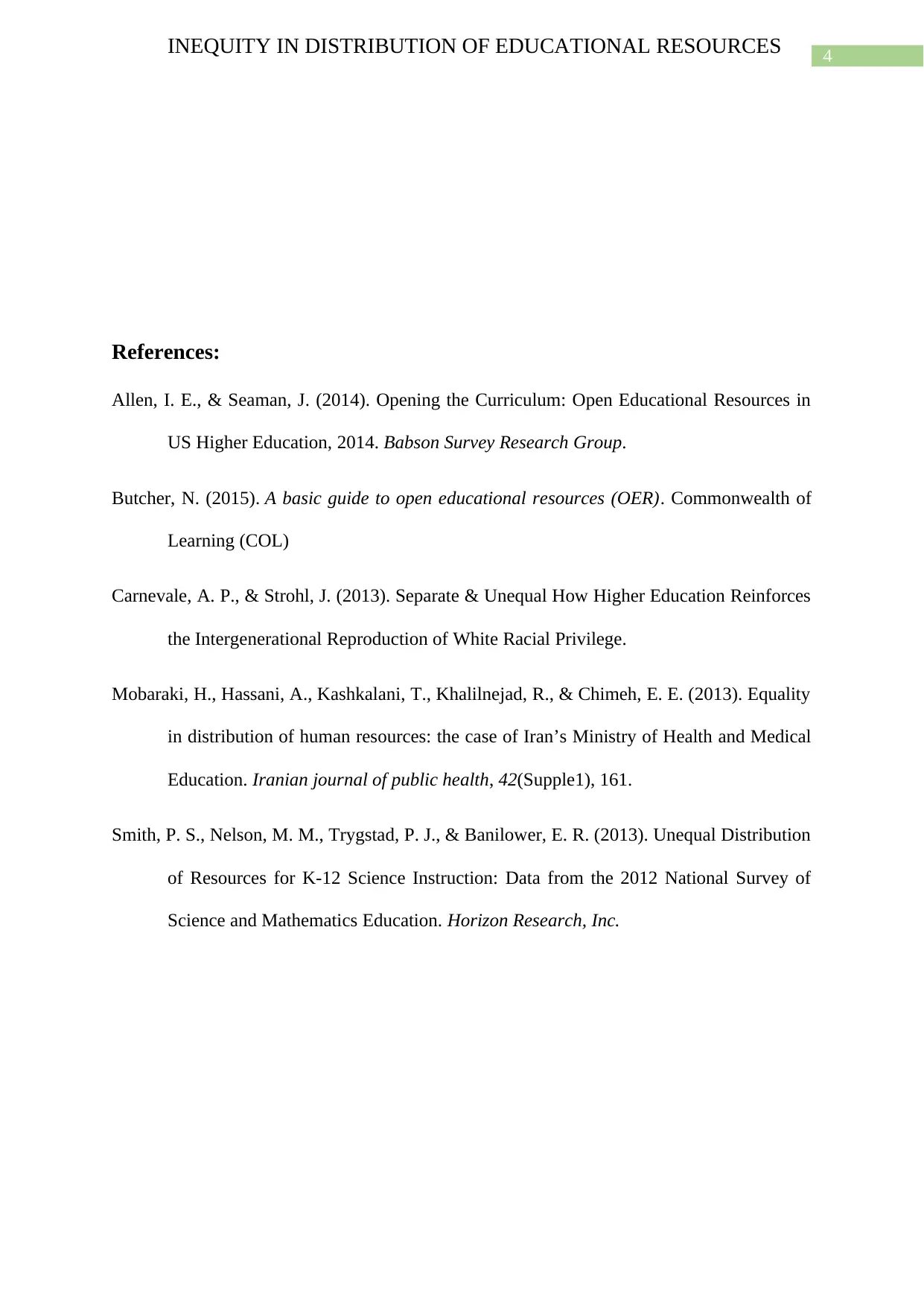
4
INEQUITY IN DISTRIBUTION OF EDUCATIONAL RESOURCES
References:
Allen, I. E., & Seaman, J. (2014). Opening the Curriculum: Open Educational Resources in
US Higher Education, 2014. Babson Survey Research Group.
Butcher, N. (2015). A basic guide to open educational resources (OER). Commonwealth of
Learning (COL)
Carnevale, A. P., & Strohl, J. (2013). Separate & Unequal How Higher Education Reinforces
the Intergenerational Reproduction of White Racial Privilege.
Mobaraki, H., Hassani, A., Kashkalani, T., Khalilnejad, R., & Chimeh, E. E. (2013). Equality
in distribution of human resources: the case of Iran’s Ministry of Health and Medical
Education. Iranian journal of public health, 42(Supple1), 161.
Smith, P. S., Nelson, M. M., Trygstad, P. J., & Banilower, E. R. (2013). Unequal Distribution
of Resources for K-12 Science Instruction: Data from the 2012 National Survey of
Science and Mathematics Education. Horizon Research, Inc.
INEQUITY IN DISTRIBUTION OF EDUCATIONAL RESOURCES
References:
Allen, I. E., & Seaman, J. (2014). Opening the Curriculum: Open Educational Resources in
US Higher Education, 2014. Babson Survey Research Group.
Butcher, N. (2015). A basic guide to open educational resources (OER). Commonwealth of
Learning (COL)
Carnevale, A. P., & Strohl, J. (2013). Separate & Unequal How Higher Education Reinforces
the Intergenerational Reproduction of White Racial Privilege.
Mobaraki, H., Hassani, A., Kashkalani, T., Khalilnejad, R., & Chimeh, E. E. (2013). Equality
in distribution of human resources: the case of Iran’s Ministry of Health and Medical
Education. Iranian journal of public health, 42(Supple1), 161.
Smith, P. S., Nelson, M. M., Trygstad, P. J., & Banilower, E. R. (2013). Unequal Distribution
of Resources for K-12 Science Instruction: Data from the 2012 National Survey of
Science and Mathematics Education. Horizon Research, Inc.
1 out of 5
Related Documents
Your All-in-One AI-Powered Toolkit for Academic Success.
+13062052269
info@desklib.com
Available 24*7 on WhatsApp / Email
![[object Object]](/_next/static/media/star-bottom.7253800d.svg)
Unlock your academic potential
Copyright © 2020–2025 A2Z Services. All Rights Reserved. Developed and managed by ZUCOL.



